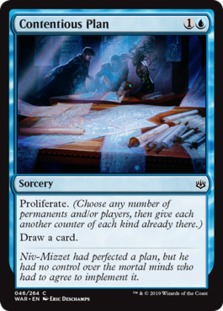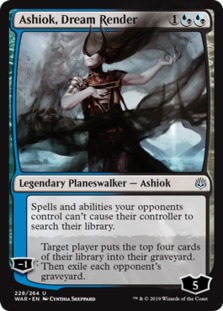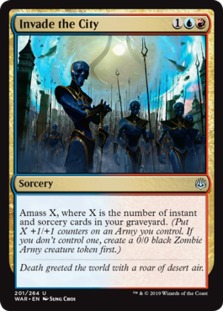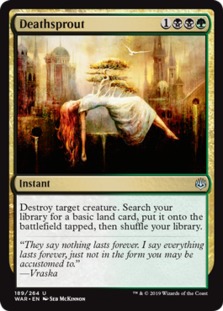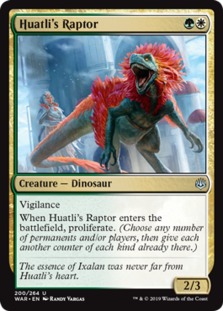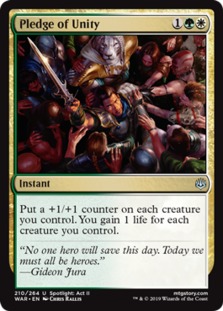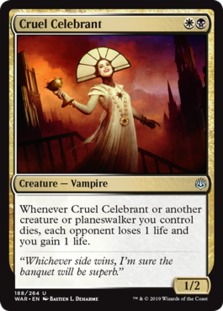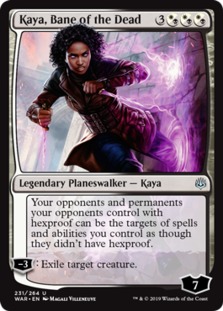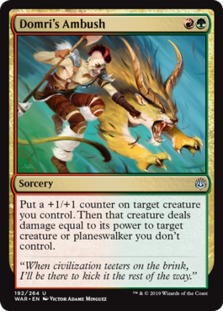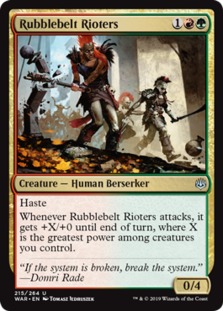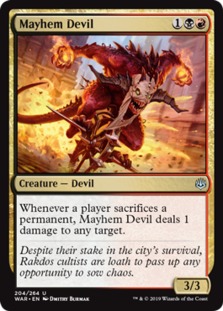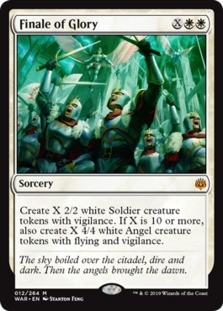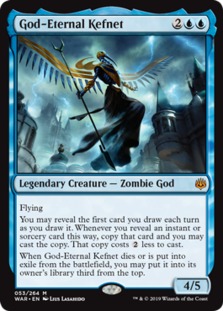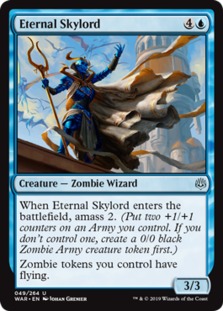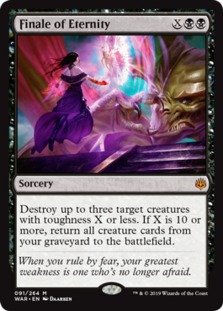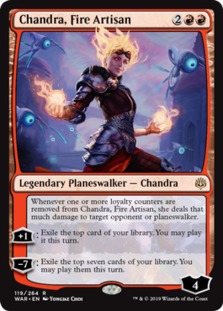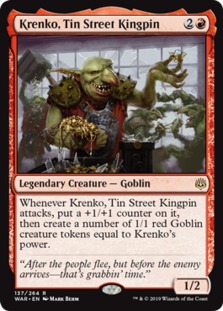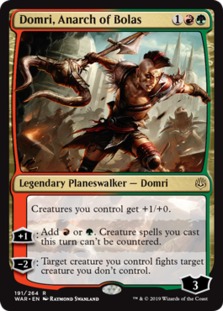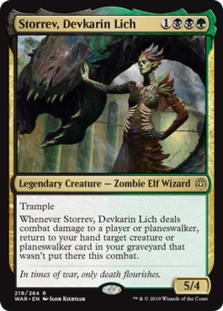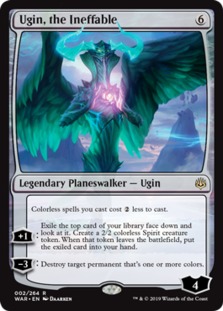Table of Contents
The Format
War of the Spark is the most powerful limited format in recent memory and maybe of all time. To my amazement, this insane power level seems to actually work. There are several notable features of WAR that make this possible:
- It is Bomb heavy – There are so many absolute bombs to potentially open that most of your drafts are going to be guided by these.
- The creatures are Strong – There are many ‘pushed commons,’ spells that are strong enough to be an uncommon in most sets.
- Removal is Strong – This seems to help mitigate the effectiveness of most of the bombs and pushed commons.
- There are SO MANY Planeswalkers – 36 to be exact, and this leads to decks playing fewer creatures than usual. In addition to and perhaps because of Planeswalkers affecting deck composition, the format has the next two interesting characteristics despite its high power level:
- The format is Slow – There are definitely some openings that can run away with the game quickly, but for the most part I have experienced games with crowded boards and several planeswalkers all doing their thing before a game winning advantage is taken.
- The format is Complex – These longer games tend to be mentally taxing. There are so many possible interactions leading to many difficult decisions. For this reason I believe the format has a very high skill ceiling. When games are filled with complex decisions, stronger players have more opportunities to distinguish themselves. It is still early, but I am very impressed with this aspect of WAR Limited and believe it is very good for the game as it ventures into Esports territory.
Overall, I am very excited about WAR as a Limited format. It is possible to build competitive aggro, midrange, and control decks. There are many viable archetypes and ways to blend these archetypes to maximize synergy. Despite all of this variety, I have noticed that most powerful decks effectively utilize the two primary mechanics of War of the Spark.
Amass
While there are several sub-themes in the set that I will delve in to later, the key mechanics are definitely these two. Amass cards create a zombie army that gets counters based on the Amass number on the card. This army can grow as you add more Amass effects (or proliferation), and there are certain cards that give your army flying, trample, hexproof, and/or deathtouch. Amass tokens are surprisingly resilient in this set because there aren’t any pacifism enchantments and even a card like Law-Rune Enforcer that has a tap-down ability cannot target the zombie army (due to it having zero mana cost). The only spells that efficiently remove the zombies are bounce spells, so keep that in mind while drafting.
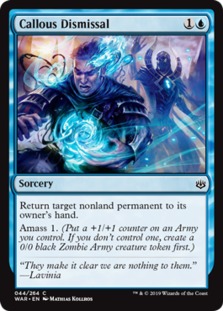
Only Callous Dismissal removes the Zombies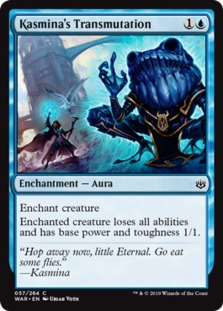

Colors that can Amass are Black, Blue, and Red to a lesser extent. While Amass can be powerful, the Proliferate mechanic can get absolutely bonkers in this format. Proliferate allows you to add a counter to any permanent that already has one. When you consider the multitude of ways to generate +1/+1 counters in this set as well as the abundance of Planeswalkers and Amass (both utilize counters) it is easy to see the potential. Green is the best color for proliferating, but White and Blue also have cards that do it.
Proliferate
Based on Amass and Proliferate alone Black, Blue, and Green appear to be the most important colors in WAR Limited. Each of these colors have powerful commons and are capable of creating rareless decks with enough synergy to compete at a high level. Blue in particular seems crucial as it has both Amass and Proliferate cards. At the same time, Red and White both contribute key cards to certain archetypes and each have strong playables at common, so neither can be completely discounted. This format is super-powered and many drafts seem to be dictated by which bomb rares and uncommons present themselves in pack 1 and the beginning of pack 2. In my next article I will be putting together ‘starter packs’ of the best commons and uncommons in each color to help you select the best cards to build around your bombs with. Typically, these colors are going to be combined into archetypes that revolve around certain mechanics and themes.
The Archetypes
In War of the Spark all ten 2-color guild combinations are present. It is helpful to get familiar with all of them and understand their strengths. Some combinations work well with the Proliferate and Amass mechanics, while others are centered on specific themes. Luckily for us, each guild has three uncommons including one Planeswalker that do a pretty good job illustrating what that guild is all about, so that is where we will start. I am going to go roughly in order of which guilds I am most to least excited about playing, but try not to read too much in to that. While I think some combinations have a higher baseline power level, if guilds are drafted in a way that builds around key cards and maximizes synergy, all of them seem to be playable.
Dimir
Key Mechanic: Amass
Themes: Control, Mill
Dimir is the best Amass archetype in the format and has access to great removal spells, the best set of uncommon planeswalkers, and creatures that are efficient enough to get aggressive earlier than you might expect from these colors. My early impression is that Dimir is one of the strongest archetypes in the format. Ashiok single-handedly opens up a mill win condition, as there are a variety of ways to power him up, recur him, or even copy him in this set. This archetype doesn’t even have to be built into a control deck to be successful, but it certainly has a lot of tools to do so.
Izzet
Key Mechanic: Some Amass
Themes: Noncreature Spells Matter
Izzet is one of the archetypes that doesn’t tend to utilize WAR mechanics very much. However, the noncreature spell theme has a ton of support and I have played/encountered a lot of very strong Izzet decks. This color combination provides a lot of quality removal and planeswalkers. The three cards above are all great examples of what the archetype does, but I will say Invade the City is very weak unless your deck is extremely instant/sorcery heavy. Overall I am impressed with the design/balancing of this archetype that allows it to stay competitive with the extreme synergy of proliferate decks.
Golgari
Key Mechanics: Proliferate and Amass
Themes: Ramp, Deathtouch
Golgari is another excellent color combination. Green brings strong creatures and proliferation, while black brings some of the best removal in the set. This archetype does really well supporting a 3rd color, with several ways to ramp/fix mana. The deathtouch sub-theme adds a bit more removal, as there are a couple spells that deal damage directly from your creatures to your opponents. Deathtouch is better than usual in this set because most players will be running less creatures due to all of the Planeswalkers. Consequently, Vraska a very good early pick and a great reason to be in these colors. Keep in mind that all of these uncommon Planeswalkers can be run in either color and aren’t necessarily tied to guilds, so taking one early doesn’t mean you have to force that particular archetype.
Selesnya
Key Mechanic: Proliferate
Themes: Toughness Matters, 4+ Power Matters
Selesnya is unsurprisingly a creature deck, and probably the strongest proliferate archetype. Both Green and White have numerous ways to add +1/+1 counters and then proliferate them. This archetype is extremely powerful when you are able to draft enough of the good proliferate cards. In terms of sub-themes, Green has a few ways to benefit from running creatures with 4+ power, and White has several high toughness creatures to payoff Huatli. Overall I do think Huatli is one of the worst uncommon planeswalkers, and that really says something about their power level, because she can be quite good in the right deck.
Simic
Key Mechanic: Proliferate, Some Amass
Themes: 4+ Power Matters
Along with Selesnya, Simic is a great archetype for Proliferation. There are many ways to generate +1/+1 counters and make more of them. Blue contributes a few quality flyers at common while Green brings proliferation and beefy creatures. Kiora is one of the bottom five uncommon Planeswalkers but plays well in green decks, especially when it can untap a land with New Horizons on it. Merfolk Skydiver has brought me into Simic a few times now and it hasn’t disappointed, but Neoform is mostly unplayable unless you have a couple bombs it can find. Finally, this is an archetype that can easily splash extra colors due to the Green mana fixing and Blue card draw. So far adding Black to create a Sultai deck has been the most potent combination for me.
Boros
Key Mechanic: Some Proliferate
Themes: Combat Tricks
Boros feels underpowered to me in this set, but I also don’t think it is bad to draft. There are a lot of good common creatures and removal spells in both colors to support an aggro deck, and especially on the play Boros is often able to put on enough pressure that opponents cannot play and protect their Planeswalkers. I think Boros works well to punish opponents that are trying to ‘game’ the slowness of the format. There are certain cards (like Tenth District Legionnaire) that benefit heavily from combat tricks, and that theme seems to work pretty well. Since most players are running fewer creatures than usual, winning combat is more meaningful. This is one of those archetypes that feels extremely strong when built cohesively, but suffers more than average when the right cards don’t present themselves.
Orzhov
Key Mechanic: Some Proliferate and Amass
Themes: Removal, Grind
The cards shown above are good payoffs for playing Orzhov, but on average I don’t think it is a great guild unless you open some Black and/or White Bombs. With the bombs it actually works really well, as Orzhov excels at staying alive and removing threats. Minus the bombs I have found this guild struggles to actually win games. There just aren’t too many powerful threats in these colors at common/uncommon. Orzhov is another Boom/Bust archetype in my opinion, but if you see the right cards don’t be afraid to go for it.
Gruul
Key Mechanic: Some Proliferate
Themes: 4+ Power Creatures Matter
Gruul has efficient creatures and solid removal, which is typically a great recipe in limited. The super-powered nature of this format is seeming to change the formula though. Samut is perhaps the worst of all of the uncommon Planeswalkers, and although Domri's Ambush is a good card it is arguably worse than Band Togetherwhich is available (at common) to any deck in Green. Don’t get me wrong, Gruul certainly has the tools to win games, but from what I have seen so far it comes up a little short in WAR.
Azorius
Key Mechanic: Proliferate
Themes: Control, Flyers
Azorius is another guild that seems to have trouble in WAR. I have seen some very strong three-color decks that feature these colors, but dedicated Azorius decks are not very scary. Elite Guardmage is an awesome card, but Dovin and his Veto leave a lot to be desired in Limited. I do like Dovin as a sideboard card, and I could see decks making use of him, but he is still one of the worst uncommon Planeswalkers in my opinion. I also think flying is pretty good in this format, but it is very difficult to win races with 2 power flyers. This guild feels like it is missing some pieces and lacks the synergy that other guilds are able to obtain more easily. Once again, there are certain bombs that could put you in these colors and you shouldn’t be afraid of that. Both White and Blue have fantastic commons and uncommons to support the bombs and win games.
Rakdos
Key Mechanic: Amass
Themes: Removal, Sacrifice
…And finally we have Rakdos. Despite having the best removal in the set, I am not very high on this guild. The creatures are weak and it is hard to be an aggro deck in this format. There are a couple rares that would still put me in Rakdos, so even though I have it last I am still not completely averse to drafting it. That really attests to how good Limited WAR seems to be, there truly aren’t any unplayable guilds. Of these uncommons Angrath is the best by a lot. Playing him for 2BB in a better archetype is usually the correct choice though. I would likely only consider Rakdos if I picked up Dreadhorde Butcher, Krenko, or Dreadhorde Invasion early. This archetype desperately needs early threats at rare as they are hard to come by at common/uncommon.
The Bombs
Last but certainly not least, I want to compile all of the bomb rares that might show up in your drafts. These are all cards that are superior to any common and uncommon and should be taken under almost any circumstance. The only reasonable exception would be when you see one Pack 3 and don’t have a realistic way to play that color. War of the Spark has way more of these than the average set so I will be breaking them down by color:
White
All three of these are must-play cards with power levels through the roof. Oketra in particular will win the game unless your opponent can race her (no easy feat). These three represent card cycles that every color has (Finale, Mythic Planeswalker, and God). Not all of those cards are going to make my Bomb list for every color, so take note of that. The other white rares in this set are mostly beat out by the best commons/uncommons I will be identifying in Part 2. Please be aware that this is a set where rare drafting is going to hurt your deck more than average. Even though there are a ton of bombs rares there are many duds as well. Lastly, notice the double-white casting costs making these somewhat difficult to splash. Double costed cards put a lot of stress on your mana base and can sometimes force you into a 2-color guild instead of splashing a third color.
Blue
Blue was tough to do this for! Commence the Endgame and Kefnet are absolute bombs, while Spark Double is more debatable. I have had it in several decks and found that it performs extremely well in this set, especially if you have some juicy targets for it. There are a lot of interesting ways to use it like copying an Ashiok to turbo-mill or copying any Legendary, really. The bonus loyalty gives you an extra activation when copying uncommon Planeswalkers, and the +1/+1 counter lets Spark Double benefit from proliferate right away. Finally, with a 3U cost it is easily splashable. There was some competition though, namely Jace and Finale of Revelation. Jace is good, but the 1UUU mana cost is somewhat prohibitive in Limited, and Finale is certainly great with a lot of mana but I have mostly found it gets outperformed by Tamiyo's Epiphany which is a (fantastic) common. The really weird thing about Blue is it has two uncommons that I would consider Bombs, Eternal Skylord and Kasmina, Enigmatic Mentor.
Both Skylord and Kasmina are great early picks that seriously perform. I would take both of them over Finale of Revelation and Jace, potentially even over Spark Double depending on the deck.
Black
Black has the most Bomb rares including the best Finale and Mythic Planeswalker. Bontu is middle of the pack for the God cycle, but still absolutely broken in Limited. Massacre Girl has performed extremely well for me, and even coming out as a 4/4 menace has been surprisingly good. I am very high on menace cards in this low-creature format. I haven’t played Dreadhorde Invasion yet, and have always beaten it when my opponent has it, but I am still certain it is good. I do prefer all of the other cards here because Invasion really narrows the scope of your deck. When you play that card you need to be ready for a race.
Red
Red also packs a lot of cards here, but they are much weaker on average than the Black bombs. Sarkhan is the best among them, and Red packs some big boys. The Boar God is the worst God in Limited, but is still a 6/6 trample that is basically unkillable. Krenko is one of the cards that snowball into some very early wins. Landing him on curve and then pumping before his first attack will often be met with a concede, but drawing him late is considerably less exciting. Chandra is good at any stage of the game or board position, is painful for your opponent to remove, and often even more painful to ignore and leave ticking. I do want to mention that Finale of Promise is a Bomb in the Izzet spells deck, but is not universally good enough to get a spot here.
Green
There are a few more good green rares such as Awakening of Vitu-Ghaziand Planewide Celebration, but these three are the only ones I would always take over Evolution Sage (uncommon). I guess instead of getting a Mythic Planeswalker Green got two rare ones? Both are Bombs but Nissa certainly lives up to her name, while Vivien provides tremendous value for 2G.
Multicolor and Ugin
These are all certified Bombs and opening them will likely put you in specific colors. Don’t be afraid to go with the flow and build around them as well as you can. Ajani wants you to draft creatures, Tolsimir hopes some of them are wolves, etc.. There are even a couple more rares I want to show here that require more effort to build around:
Both of these cards can be Bombs in the right deck, but do a lot less on their own than the others I showed above. Probably the best way to support your bomb rares is to draft the best commons and uncommons in those colors. To aid you with that I am going to be going over all of those in Part 2!
I hope you found this guide helpful. Please leave me some feedback in the comments and I will see you in the next one. If you want to see me do some live drafts with commentary, please follow me on Twitch (twitch.tv/compulsion02). I have started uploading some videos on YouTube (https://www.youtube.com/user/compulsion02) as well. If you are feeling generous, the best way to support me is the paypal donate button below. You can also subscribe to me on Twitch (for ‘free’ if you have Amazon Prime). War of the Spark Limited Guide (Part 2) can be found here: https://mtgazone.com/war-of-the-spark-limited-guide-part-2/
Premium >
Enjoy our content? Wish to support our work? Join our Premium community, get access to exclusive content, remove all advertisements, and more!
- No ads: Browse the entire website ad-free, both display and video.
- Exclusive Content: Instant access to all exclusive articles only for Premium members, at your fingertips.
- Support: All your contributions get directly reinvested into the website to increase your viewing experience!
- Discord: Join our Discord server, claim your Premium role and gain access to exclusive channels where you can learn in real time!
- Special offer: For a limited time, use coupon code L95WR9JOWV to get 50% off the Annual plan!

























